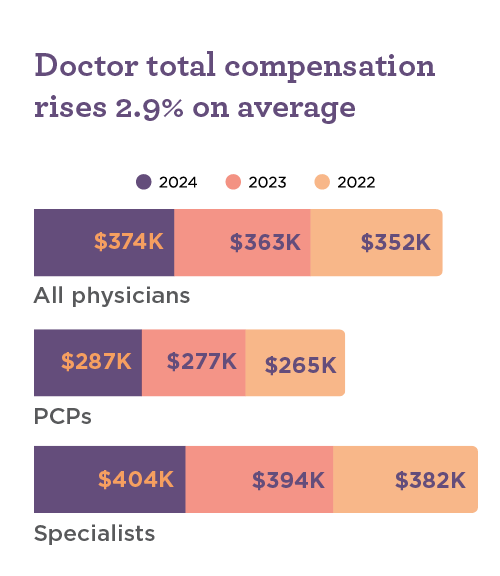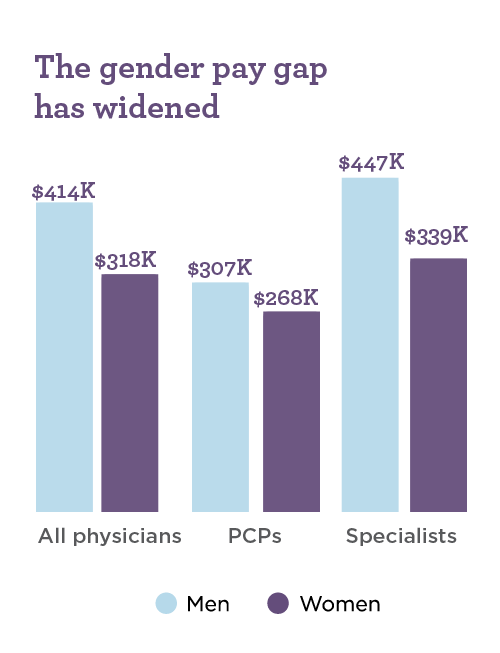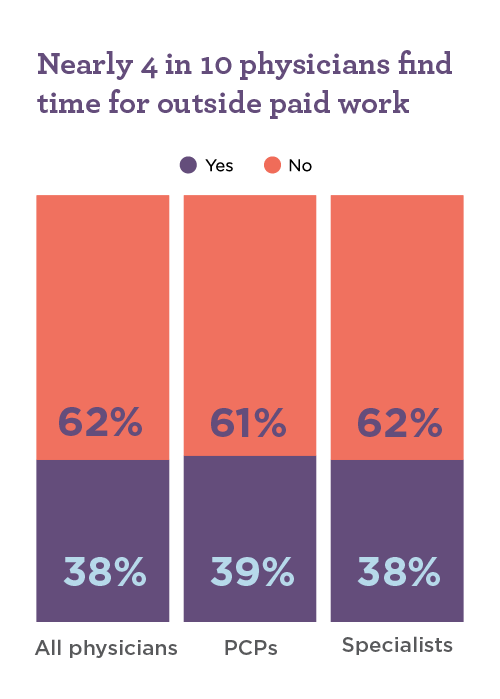Physician compensation trends: What healthcare leaders need to know now
October 16, 2025
The latest trends in physician compensation send clear warning signals for health systems worried about physician retention and morale. With physician salaries facing stagnation across the board and pay gaps widening, health leaders should be aware of current physician compensation trends and reexamine their pay strategies with an eye to retention.
Here, we take a deep dive into the Medscape's 2025 Physician Compensation Report to uncover the nuances of the current compensation picture and provide actionable strategies for boosting physician satisfaction, improving pay equity, and retaining your valuable physicians.
All-around compensation is flat
On average, physician compensation grew by a slight 2.9% in 2024. This is a tick down from the 3% increase in 2023; this year’s growth is among the slimmest gains reported in the 14 years Medscape has compiled its annual physician compensation report.

Primary care physicians did slightly better, with an average 3.9% increase. However, specialists achieved only 2.4% compensation growth, the lowest since Medscape’s 2021 report. Half of all specialists reported a pay increase of 2% or less, with many specialties seeing declines.
The picture looks bleak when looking at all-around compensation, including salary, bonuses, and other compensation. About 70% of physicians said that when considering the total package, their compensation was either flat this year or rose by no more than single digits.
In a period of rising inflation, dampened compensation growth is hitting physicians hard. “The cost of goods and other services like insurance have nearly tripled in the last 10 years, while my compensation has remained the same,” notes one physician in the report.
Why physician compensation is getting squeezed
The Medscape report calls out several factors that contributed to weak compensation growth, including:
The continuing financial burdens facing healthcare organizations, which are seeing operating margins hovering around 1%
Five consecutive years of cuts to CMS reimbursement rates
A fade-out of post-pandemic pay increases and retention incentives
Flat patient volumes for some specialties, which impacts physicians working under RVU-based models
The gender pay gap has widened
Over the past three years, the gender pay gap has grown. Overall, the gap now sits at $96,000, and for specialists, it has reached $108,000. The Medscape report notes that female physicians are underrepresented in the highest-paying specialties, and this imbalance contributes to the gender pay gap.

Physicians are increasingly frustrated
The slow pace of income gains has left many physicians feeling frustrated and worried about the future.
It’s the uncertainty of income that has become a problem. A doc needs to be paid more today because there may or may not be any income tomorrow.
Modest income growth has also caused a slide in the perception of fairness. This marker has fallen from an all-time high in 2021 to a 10-year low, with only 52% of physicians reporting feeling fairly paid. The number worsens when physicians consider the profession as a whole: About 60% say the profession does not receive fair compensation.
Give your staff some much-needed support: 4 ways locums can improve patient well-being
Physicians are supplementing their income
Physicians have plentiful opportunities to supplement their income with side gigs in a time of ongoing provider shortages. The Physician Compensation Report found that nearly 40% of physicians are engaging in outside paid work, which holds true for both primary care providers and specialists.

Physicians are taking extra telemedicine shifts, moonlighting gigs, or locum tenens opportunities. In fact, 47% of physicians who start locum tenens work do it to supplement their core income, according to CHG Healthcare's 2024 Locum Tenens Awareness & Perception Survey.
Why physicians choose locums: Pay, flexibility, and career satisfaction
Physician retention strategies
Dissatisfaction with compensation can have serious consequences for healthcare organizations. If your physicians feel unfairly paid and are not seeing meaningful salary growth year over year, your organization will face increasing turnover rates, decreased provider morale, and worsening recruitment challenges.
For leaders wondering how to improve physician retention in hospitals, the following strategies can support physician compensation planning aimed at retention and engagement.
Review and adjust compensation packages. Physician compensation planning for healthcare executives should include regular reviews of the total package, including bonuses and other incentives. Compensation should be benchmarked against regional and specialty trends to ensure competitiveness.
Set the stage for fairness. Policy changes can help mitigate persistent gender and racial pay gaps. For example, standardized starting wages and pay structures create a baseline of fairness. Internal audits for pay equity can help address entrenched fairness challenges.
Address burnout. In a 2025 study, 45% of physicians reported at least one symptom of burnout. Pervasive burnout combined with a sense of salary stagnation can supercharge physician turnover. To ameliorate burnout, health systems should focus on:
Reducing the administrative burden by investing in artificial intelligence (AI) scribe tools or hiring additional administrative support staff
Adopting flexible schedule options that give physicians more control over their work-life balance
Utilizing locum tenens providers to fill in the gaps and prevent permanent staff from being stretched thin
Foster dialogue. Keep your finger on the pulse of physician sentiment by creating regular opportunities for informal and formal discussion with physicians. Healthcare executives can participate in daily rounding, host informal meetings, keep physicians informed about key decisions, and schedule one-on-one meetings, among other communication tactics.
Support financial wellness. Provide robust financial planning resources to help physicians gain control over their financial situation. For example, you can host workshops that address physicians' unique financial situations and provide HR resources to ensure physicians are taking advantage of all available benefits.
With physicians seeing only minimal compensation increases and growing pay gaps, healthcare leaders should be aware that increasing burnout and turnover is a real risk. To mitigate that risk, executives must evaluate pay strategies, work to reduce unfairness, and seek dialogue with physicians to understand their perspectives and career goals.
Do you need help hiring physicians to staff your facility? Give us a call today at 800.453.3030 to get started.